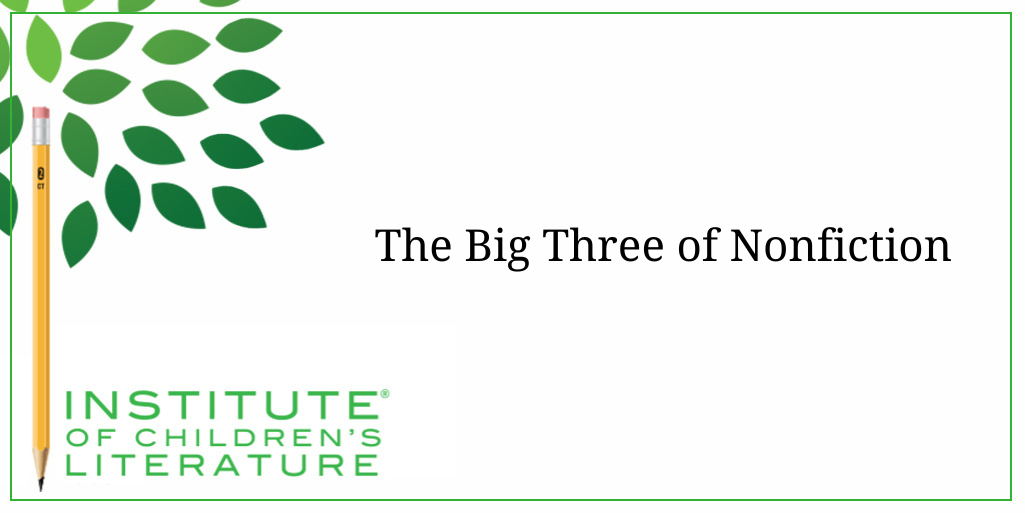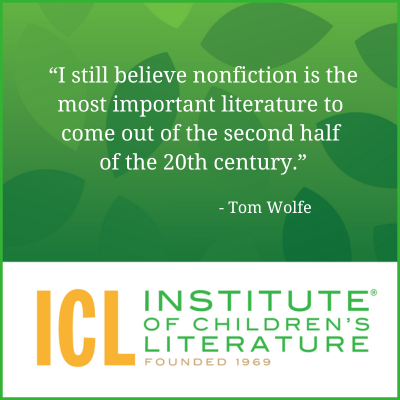
The Big 3 of Nonfiction
The three essentials for any publishable children’s nonfiction are accuracy, clarity, and organization. Let’s look at these tips for success in nonfiction.

Many newer writers don’t consider nonfiction when deciding what they would enjoy writing. They see it as less creative or less interesting. And they associate it with homework, which many of us don’t remember fondly. And yet, nonfiction is an amazing, varied, and prize-winning field. It is always in demand and offers as much room for creativity as fiction, as long as you keep in mind the things that nonfiction absolutely must do, and the skills nonfiction writers must have and display in their work.

The three absolute essentials to any publishable children’s nonfiction are accuracy, clarity, and organization. The three work hand in hand whether the nonfiction is designed to be read for fun by a cool facts enthusiast, referenced to write reports for school, or used to make events and people of the past compelling and relevant to children today. No one of these three is more important than the other, but your nonfiction will not be successful if you lack any of the three.
Accuracy is managed by careful, methodical research. Researching kids’ nonfiction requires every bit as much rigor as researching adult nonfiction. You begin by accepting that what you think you know might not be right, so don’t accept anything as a given. For example, if you believe hummingbirds eat only nectar from flowers (or sugar water from feeders) then you’re laboring under a false belief, not a fact. Hummingbirds also eat insects—and rather a lot of them.
Most of us have many “facts” we have stored in our heads that might not be correct. So, check your facts, even those you already know. Don’t accept “common sense” or “everyone knows that” as reason enough to include something without checking. Most editors of children’s nonfiction know to be careful about facts, and you will be asked to prove what you said is true, even when it’s something “everyone knows.”

Check the sources and let them convince you that they know enough not to make mistakes. That means not using ANY source where you cannot find the name of the person who did the actual research. All by itself, that will eliminate most of the inaccurate information on the Internet. Then when you have the person’s name, investigate who that person is and why you should trust their scholarship. If you do that, you’ll be far less likely to pass along poor scholarship and inaccuracies.
Because of the importance of good research, you are likely to be digging deeply into academic sources written for adults. Though children’s books often reflect excellent scholarship and research, they are usually not allowed as sources. Unfortunately, adult books often differ in tone, pacing, and approach from children’s books. You may also be doing interviews with experts in their field.
Both adult books (especially academic books and journals) and experts in the field tend to fill your head with jargon and stilted academic voices. Your job is to translate that into a clear, simple, accurate voice. That can be difficult when you’ve been deep in the weeds of academic journals and research reports. As writers, our voice can be pulled in different directions depending upon the voice of the writing we’ve been reading. Thus, our writing voice can stiffen up without our noticing, and that will create problems when writing for kids.

Your goal of making the material work for kids needs to avoid two pitfalls: perky tone and simplifying to error. The perky tone is obvious. That means don’t write as if you’re trying to cajole a young child into eating their vegetables. You’re not. You won’t need to cajole if you’ve picked the most interesting possible topic and focus, because you’re writing for readers who will find it interesting also. Don’t treat your nonfiction like medicine that needs to be sweetened, but as information that you chose because it is interesting, unexpected, or surprising. You can’t perk up a dull topic by being chipper, but you can annoy a reader by sounding condescending.
The other issue, simplifying to error is more insidious. Be certain your topic matches your age level so that you don’t need to condense a complex field of study into a few simple words. For example, you cannot simplify many physics concepts for early elementary students without introducing errors. This is because the prior knowledge needed to understand the higher-level concepts is simply not there with younger readers. That isn’t because young readers aren’t smart, nor does it mean they cannot think deeply. Instead, it means you simply need to know too much to make sense of the complex material and you won’t have the space or word count to help your reader reach that level of prior knowledge necessary to truly understand this high-level subject.
When writers try to do that anyway, they often employ analogies that don’t fit well or they trim off too much of the subject, leading to information that can be misunderstood easily. You need to pick topics that are interesting and lively, but that also meet the reader where they are in terms of knowledge base. If you choose your topic and focus well, you won’t be trying to turn rocket science into preschool books.
Clarity is helped along by clear organization of your material. The first step in organization is to decide the scope of the topic you intend to cover. For instance, if you are writing something biographical, are you going to focus on a specific incident out of the person’s life, an incident that illustrates a theme? Are you going to use the biographical information to improve the reader’s knowledge of a subject?

A specific incident focus lets you tell a single story in the person’s life while ignoring lots and lots of facts about the person. A specific incident focus often includes back matter to flesh out the story. For fiction writers, this kind of focus often has the most appeal as fiction writers already know how to tell a story. That doesn’t mean it doesn’t require considerable research. To make the story you tell accurate, you’ll need to acquire lots of information so you can include accurate sensory details of the setting, details of the time period, and any major events surrounding the incident. This side information may creep in to add depth and clarity and will require time and careful research.
Using a specific person to illustrate a field of study requires knowledge of both the person and the field of study. For example, books and articles about Dian Fossey or Jane Goodall will also help the reader understand important things about great apes.

Books and articles with a more encyclopedic or report-purposed organization will often have many facts about a subject, and these will need scrupulous organization. They aren’t jumbled bits of information. Instead, they will be carefully organized by type and then presented in groups, often with subheadings to help the reader follow when you’re switching from one sub-topic to another.
For example, an encyclopedic type of biography will often have subsections that cover aspects of the subject’s life like “early years,” “trials and errors,” and “why they are important today.” Notice also that these three divisions are also somewhat chronological. This kind of organization is sometimes easiest when dealing with broad biographies.
Sometimes a good checklist is one of the best ways to ensure your nonfiction is doing what you want it to do. Here’s a checklist of what editors will be looking for in your children’s nonfiction:
Nonfiction Beginnings
_ Did you grab the reader’s interest in a clever, engaging way without being too perky?
_ Did you keep in mind the reader’s age when choosing your topic? Is this something that will interest children in your target age group? Will this child have sufficient prior knowledge of this topic?
_ Does your opening introduce the topic and focus? Does it make some kind of connection with the reader (while avoiding the dull “have you ever” question)?
_ Does this beginning prepare the reader for the content the piece will deliver?
Nonfiction Middles
_ How do you describe the organization you’ve chosen? Is it big picture to specifics? Is it cause and effect? Is it chronological? You need to choose an organizational form and stick with it throughout the piece.
_ Is every paragraph about one thing? Have you avoided letting sentences creep into paragraphs that have nothing to do with the rest of the paragraph?
_ Have you avoided introducing information that is unrelated to the topic and focus your introduction promised?
_ Are your transitions smooth and clear? Does the piece have an overall feeling of order and sense?
Nonfiction Endings
_ Do you have a clear ending, or did you simply stop writing when you ran out of facts and information?
_ Have you ended with something clever or amusing? (Bonus points for this.) Does your ending somehow tie into the beginning? (This can give a nice sense of completeness.)
_ Have you avoided changing your focus, tone, or subject at the end? The ending needs to give the feeling of wrapping up, not wandering into new territory.
_ Is the ending short? An ending only needs to be a paragraph or a sentence that brings a sense of conclusion to the overall piece.
Stopping at the end of the checklist would mean this piece didn’t feel like it had an ending, even though adding a checklist is a useful tool for the reader. Endings are important to the success of your article or your book. Humans crave that feeling of completion. Without a clear ending, a nonfiction article or book is emotionally unsatisfying. So never leave your reader hanging. When you’re done, let them know. And now, I’m done.
With over 100 books in publication, Jan Fields writes both chapter books for children and mystery novels for adults. She’s also known for a variety of experiences teaching writing, from one session SCBWI events to lengthier Highlights Foundation workshops to these blog posts for the Institute of Children’s Literature. As a former ICL instructor, Jan enjoys equipping writers for success in whatever way she can.

The three essentials for any publishable children’s nonfiction are accuracy, clarity, and organization. Let’s look at these tips for success in nonfiction.

What does show don’t tell mean when it comes to nonfiction? Jan Fields shares examples of using sensory details to bring true stories to life for the readers.

Part of writing children’s books that can be used in a school setting lies in meeting the needs of the reader. Here are 4 steps to improve readability.
1000 N. West Street #1200, Wilmington, DE 19801
© 2024 Direct Learning Systems, Inc. All rights reserved.

1000 N. West Street #1200, Wilmington, DE 19801
© 2024 Direct Learning Systems, Inc. All rights reserved.

1000 N. West Street #1200, Wilmington, DE 19801
©2024 Direct Learning Systems, Inc. All rights reserved. Privacy Policy.